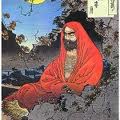 As ideas migrate they change as they stay the same. This seems to happen in much the same way that people pass on genetic characteristics. If one tribe with black hair intermarries with another tribe that has blonde hair then occasionally a recessive gene expresses itself and an atypical physical attribute expresses itself… but although this particular child may look different then the others s/he is still a member of the same tribe and the tribe retains its basic culture and identity.
As ideas migrate they change as they stay the same. This seems to happen in much the same way that people pass on genetic characteristics. If one tribe with black hair intermarries with another tribe that has blonde hair then occasionally a recessive gene expresses itself and an atypical physical attribute expresses itself… but although this particular child may look different then the others s/he is still a member of the same tribe and the tribe retains its basic culture and identity.
The concept of Budo is the result of a similar process of migration as an idea that starts in India, travels and transmutes through Asia, until it eventually arrives in Japan to be influenced by a Samurai world view.
It seems to have begun when a man (Siddhartha Gautama/Shakyamuni) somewhere in Nepal decided to sit under a tree until he found “an end to suffering” (enlightenment). Legend says that this practice was carried to China by Bodhidharma where it intermingled with Taoism and where sitting is called Ch’an. Tradition stipulates that Bodhidharma sat facing a wall in a cave near a Shaolin Monastery for nine years. Although he was silent he left behind an iron chest with two texts. The first text disappeared but the second text, “The Muscle Change Classic”, became the guarded treasure of the monks who incorporated it into their martial arts practice.
This association of Bodhidharma with the idea that spiritual, intellectual, and physical excellence are an indivisible whole necessary for enlightenment, proved highly attractive to the Samurai class in Japan. As the idea crosses the sea from the continent to the islands Japanese pronunciation transforms “Tao” to “Do” and “Ch’an” to “Zen”.
As a warrior class Samurai were constantly aware of their mortality, a human condition that often leads to questioning the meaning of existence. They were particularly drawn to the Rinzai School of Zen because it was reputed to remove all fear of death via direct experiential transformation of consciousness. For a Samurai, fear of death was naturally a great obstacle, so such Zen practice had practical applications and became the philosophical basis of bushido. Bushido demands the willingness to face death. According to Zen principles, fear can only be truly conquered by eliminating the notion of self. It is from here that the migrating idea of the Buddha becomes the Japanese concept of Budo.
The sword is known as the “soul of the Samurai”, and in Japanese mythology it was one of the three sacred gifts given to the emperor by the Sun Goddess. A Samurai’s sword was believed to be imbued with certain spiritual qualities of its owner. The forging of the blade itself was considered a religious ceremony, swathed in ritual, passed down in secret from father to son for generations. The ceremony was consistent, precise, unvaried, and beautiful — in action, dress, and color. Forging was often done at night and temperatures were set by holding the blade to the color of the morning sun. The exact hue was transmitted from master to apprentice down through centuries.
The sword forging process itself became a metaphor for character development and many of the metallurgical processes parallel the tasks required for shaping the spirit. The concept of “tanren” is central to this theme.
Tanren means to forge in the same way that a sword blade is forged, with hard work, and sweat, and many hours of dedication, folding together the hard and soft elements in the body, mind, and movement just as the sword gains its strength out of hard and soft steel.
This is followed by “Renshu”. Ren means to polish, to perfect by continued practice. It also means to polish the spirit and character through the requirements of detail and interpretation. To demonstrate a compassionate nature that can pass on knowledge without egotistical pride and arrogance. Miyamoto Musashi, the legendary 16th century Japanese sword master, states in his “Book of Five Rings” that it takes 1,000 days to forge the spirit and 10,000 to polish it.
So it came to be in more modern times (in Japan this could be seen as starting with the Meiji Reformation) that a primary goal of Budo was to develop character. The physical practice of Budo transcends the notion of sport. It transcends the idea of competition. It views self-defense in a much more sophisticated way.
Because of such a great promise there are high expectations. Wherever there is a great height there is the danger of a great fall. This is as true with abstract ideals as it is with concrete reality. There is the “talk” about the ideals of Budo and the “walk” of the path. Disappointments and errors occur along the journey and the fall is accompanied by sadness and doubt.
But part of the training in Budo is to learn how to fall and arise from the throw ready to continue. Consequently one must remember that there is “no escape” and readjust the keikogi and return to “fight the good fight”. This doesn’t mean that the experience hasn’t left feelings of doubt and discouragement. These are the challenges (physical and psychological) to training and living. They are the heat and the hammering that represents the forging of character.
This is the difficulty of living with integrity in the “real world” and the hardships experienced along the way. These are the requirements for forging a blade that “never bends, never breaks, cuts clean”.
R. A. Whelan
Godan, Shidoin
Shodokan
